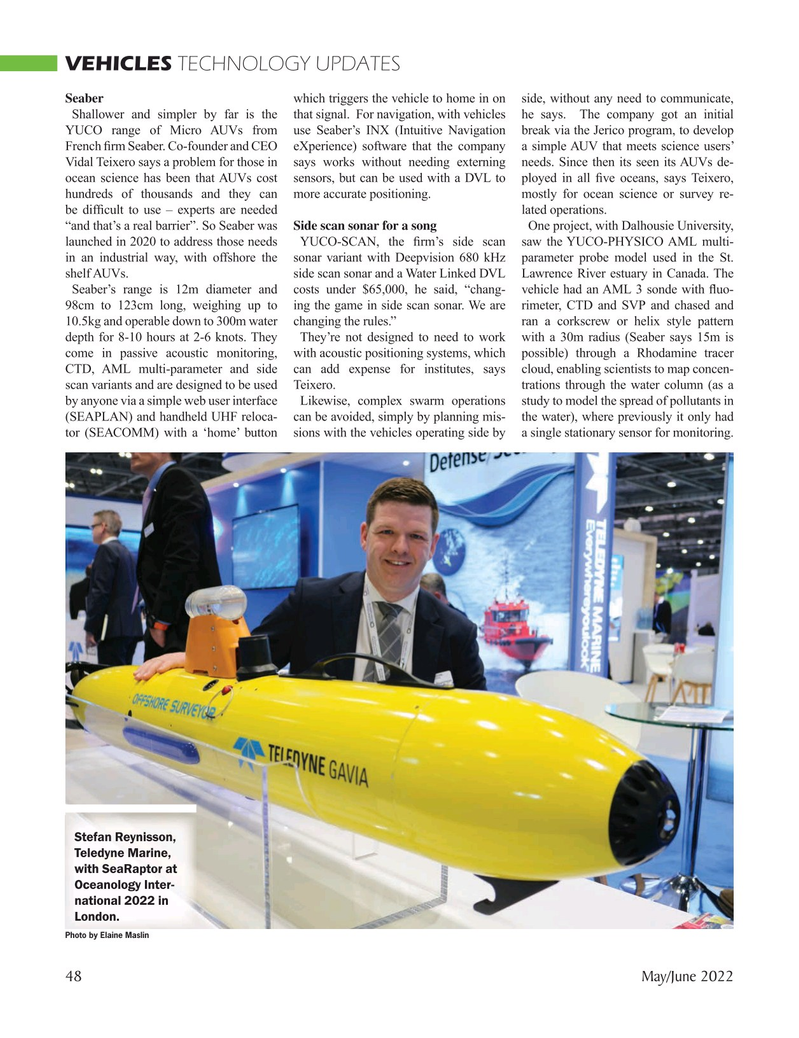
Page 48: of Marine Technology Magazine (May 2022)
Read this page in Pdf, Flash or Html5 edition of May 2022 Marine Technology Magazine
VEHICLES TECHNOLOGY UPDATES
Seaber which triggers the vehicle to home in on side, without any need to communicate,
Shallower and simpler by far is the that signal. For navigation, with vehicles he says. The company got an initial
YUCO range of Micro AUVs from use Seaber’s INX (Intuitive Navigation break via the Jerico program, to develop
French ? rm Seaber. Co-founder and CEO eXperience) software that the company a simple AUV that meets science users’
Vidal Teixero says a problem for those in says works without needing externing needs. Since then its seen its AUVs de- ocean science has been that AUVs cost sensors, but can be used with a DVL to ployed in all ? ve oceans, says Teixero, hundreds of thousands and they can more accurate positioning. mostly for ocean science or survey re- be dif? cult to use – experts are needed lated operations. “and that’s a real barrier”. So Seaber was Side scan sonar for a song One project, with Dalhousie University, launched in 2020 to address those needs YUCO-SCAN, the ? rm’s side scan saw the YUCO-PHYSICO AML multi- in an industrial way, with offshore the sonar variant with Deepvision 680 kHz parameter probe model used in the St. shelf AUVs. side scan sonar and a Water Linked DVL Lawrence River estuary in Canada. The
Seaber’s range is 12m diameter and costs under $65,000, he said, “chang- vehicle had an AML 3 sonde with ? uo- 98cm to 123cm long, weighing up to ing the game in side scan sonar. We are rimeter, CTD and SVP and chased and 10.5kg and operable down to 300m water changing the rules.” ran a corkscrew or helix style pattern depth for 8-10 hours at 2-6 knots. They They’re not designed to need to work with a 30m radius (Seaber says 15m is come in passive acoustic monitoring, with acoustic positioning systems, which possible) through a Rhodamine tracer
CTD, AML multi-parameter and side can add expense for institutes, says cloud, enabling scientists to map concen- scan variants and are designed to be used Teixero. trations through the water column (as a by anyone via a simple web user interface Likewise, complex swarm operations study to model the spread of pollutants in (SEAPLAN) and handheld UHF reloca- can be avoided, simply by planning mis- the water), where previously it only had tor (SEACOMM) with a ‘home’ button sions with the vehicles operating side by a single stationary sensor for monitoring.
Stefan Reynisson,
Teledyne Marine, with SeaRaptor at
Oceanology Inter- national 2022 in
London.
Photo by Elaine Maslin 48 May/June 2022
MTR #4 (34-49).indd 48 4/29/2022 2:58:59 PM

 47
47

 49
49
